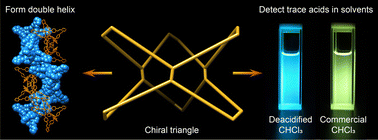Luminescent chiral triangular prisms capable of forming double helices for detecting traces of acids and anion recognition†
Abstract
Orchestrating stimuli-responsiveness, molecular recognition, and self-assembly in macrocycles plays a vital role in the preparation of multifunctional materials. Herein, we report a pair of triangular prismatic enantiomers (R)- and (S)-Δ based on tetraphenylethylene (TPE), which assemble into left- and right-handed double helices, respectively, in their single-crystal X-ray superstructures. Due to the geometrical constraint of triangles to the phenylene rotation within TPE, their emission is enhanced significantly. In addition, their fluorescence and circularly polarized luminescence change from blue to yellow in response to traces of acids in solvents, which, combined with enhanced intensity, makes them sensitive indicators for the quantitative detection of the acid present in common organic solvents such as CDCl3, CH2Cl2, and CHCl3, with a detection limit as low as 5 × 10−7 M. Furthermore, the cavity of triangles can bind I3− to form host–guest adducts by single-crystal-to-single-crystal transformation.

- This article is part of the themed collections: Photofunctional Materials and Transformations, 2023 Journal of Materials Chemistry C Lunar New Year collection and 2022 Journal of Materials Chemistry C Most Popular Articles


 Please wait while we load your content...
Please wait while we load your content...